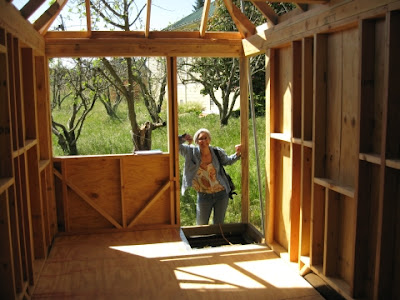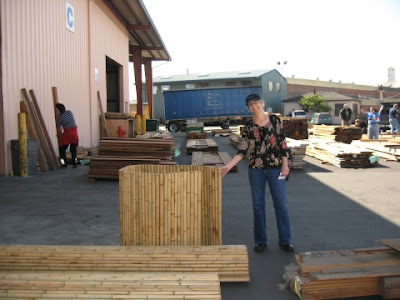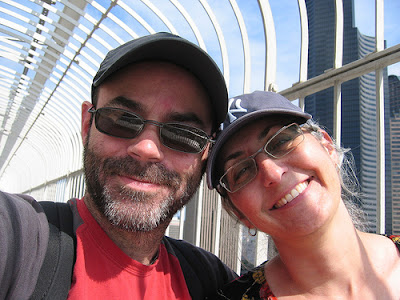The following information describes our building project. If you have other questions, don’t hesitate to ask. We can reached at "mobilecottage.blogspot at gmail.com"
Why are you building a tiny house to live in?This tiny cottage began as a project that we thought would be fun to work on together. We have both been interested in architecture since we were very young, have wanted to build our own home ‘someday’ since we were old enough to be out on our own, and are experienced ‘tool people’ so building it ourselves seems easily possible.
What does this project mean to you?Building this tiny home is a way that we can live our dream of designing and building our own home. We’re building it with VOC free, high quality building materials. It will be very energy efficient with minimal material usage or solid waste going into a landfill. Without a mortgage we will have more freedom and options. This is our solution to help with environmental concerns and sustainability while lowering our living expenses. We purposely chose a cute exterior design so that people wouldn’t mind looking into their backyards and seeing us there.
Won’t it be too small for you two to live in full-time?We are building a slightly larger version than some of the designs we have seen. Some people think that living in a space this size is impossible but there are many couples (and families) who happily live on boats or are full-time RVers. This type of living situation can work, and maybe because of the current hard economic times, there will be many who never thought it possible but who are now considering simplifying their lives as well as spending less on housing / utilities.
Why do you think it’s important to downsize your possessions?In this country house sizes continue to grow. Larger houses create more land fill and waste, have larger power consumption needs, require larger lots, and more furniture. If we're buying more things for our bigger houses, then we need more square footage for our stores and bigger parking lots. We wonder why our commutes are so long!
We don't think this trend is sustainable and we want to do our part to help change things. Instead of commuting, we’d rather go hiking, take classes or socialize with friends. Paring way down to the minimum that we need, plus a few items that simply make us smile, and moving into a healthy, small, energy efficient environment is our reaction to all of this. We’d love to get to know our new neighbors and be part of the community and we think our tiny house is a step in that direction.
How do you think this project will change your lives?We have never lived in a space the size of our tiny cottage for longer than a month but we’re certain that whatever challenges come with living in close quarters, we’ll figure out a solution that will make us both happy. We’ve read a lot about living full-time in small spaces (boats, RV’s) and can’t see any big problems with this that can’t be worked out. We already know that we travel light, enjoy each other’s company, are laid back and are willing to compromise. For a month long overseas trip we took a few years ago, we brought one carry-on each and really had a great time even during long car rides in the very tiny rental car.
What are the facts about your tiny cottage?* Our tiny cottage exterior measures 8.5’wide and 24’ long (including the length of the trailer tongue).
* We will be using a propane tank for cooking and heating. Other tiny home owners say that heating during the winter even where there is snow costs them less than $10 a month.
* We have a composting toilet so we don't need a sewer hookup. No, it doesn’t smell like the porta potties in the park do. The compost is harvested about 3 to 4 times a year. The final product (thankfully) looks nothing like what goes into making it.
* We will need a garden hose hookup for dishes and showers when we aren’t at the YMCA or UW gym. The hose is an RV hose that can be heated using a tiny amount of electricity during really cold days so it won’t freeze.
* We have few appliances, so an outdoor extension cord from a host house will be fine. Someday we plan to go solar because our electric requirements will be so low.
* Our water from dishes and showers will be recycled (as we'll use only biodegrade soaps) by watering nearby plants so we’d like to have a few containers with vegetables or flowers in front of our cottage or would like to plant a small raised bed garden nearby.
* Building codes? The majority of municipalities have minimum size requirements and other constraints even for ‘accessory buildings’. However, trailers are not fixed structures so they have different legal requirements than local building codes.
What are you looking for?* A 30 minute or less commute by public transport to the University District.
* We’re not interested in publicity so we’d like to be placed somewhere that the general public won’t be stopping by to peek in the windows out of curiosity or bothering the homeowners that we rent space from by walking uninvited up their private drive to get a better look at our cottage.
* A reasonable monthly rent as we only need a parking space sized area, our utility use will be very minimal, and we’ll be outside of your home so you’ll still have privacy. We bring our own ‘room’ (kitchen/bath/bedroom/living room) but expect to pay about what a room rental costs since we take up as little space. Rooms for rent seem to be running $400+ currently in Seattle near the university. Utilities could be added on top of the basic rent if it’s found that our usage shows on the monthly utility bills.
* Arlene is willing to help with house repairs/remodeling (she'll have a bit of experience in all areas by then) or gardening for an agreed upon number of hours per week in exchange for paying a rent close to the amount suggested above. Maybe someone has an elderly relative who needs help around the house or who could use some extra income? Pet/house sitting while our host travels is an option too as well as daily dog walking.
* Arlene will be looking for work upon relocation to Seattle. She’d like to possibly continue doing CADwork for consulting engineering firms but will also be looking at architectural firms who work on LEED projects. She is currently pursuing LEED certification so work as a consultant for other projects such as this one, for environmental conservation with respects to the building industry, or as someone who deals with recycling building products so they don’t end up as landfill, might also be options. She is also currently working on creating innovative LED light fixture designs.
Have there been any parts of this project that were unexpected?For such a small project it’s actually effecting our lives in many ways. We’ve learned much more about each other and it’s improved our skills of communication, cooperation and compromise. We’ve also become much more knowledgeable in ecological conservation issues and which sustainable building products are readily available (and affordable) than we thought we’d need to be for this project.
What would you tell others who see your tiny cottage and want to build one too?If you’re not an experienced builder then do your research ahead of time so your project will go smoother; use the library. We did this and were very happy that we did. Also, realize that no set of plans that you might buy will be set in stone. Because your trailer dimensions will vary, your needs and wants will vary from the designers’, you will need to change the construction plans. We never found a set that was complete so being able to make decisions based on the previous knowledge one has about building (for example, “If I do this, then what else will it effect?”) , and to get things done on the fly, will come in very handy.
Other FAQswhat model hot water heater you installed? Precision Temp RV-500.
It's a tankless, on demand, propane hot water heater.
http://www.precisiontemp.com/pt_rvmd_rv500.html










